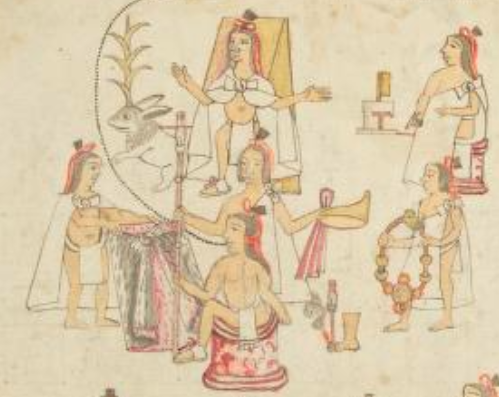cozcatl (Azca19)
This painted black-line drawing shows an example of iconography featuring a large necklace, which is not glossed but might be considered a cozcatl. The contextualizing image shows how large the necklace is compared to the man who is holding it. A large, not visible scene suggests that this necklace will be worn by a tlatoani who is being crowned and given a cloak. The necklace is a cord with the head of a gold-colored bird at the top of the loop where a tie might be expected. The bird has a straight beak, not hooked like an eagle or other raptor. The cord is red. Two gold beads appear on the cord on each side, with spaces between them. At the bottom of the necklace is an object that has the appearance of the glyph for jade (chalchihuitl), even if it is not the typical color. It has one larger circle of gold in the center, with a white band around that, and a red border. Around the perimeter of this larger circle are four, fairly evenly spaced, smaller gold beads with red borders.
Stephanie Wood
See below for other examples of necklaces and jade beads. In this example, the process of removing the hands meant we had to fill in a bit of the missing necklace.
Stephanie Wood
post-1550, possibly from the early seventeenth century.
Jeff Haskett-Wood
collares, cabeza de pájaro, cuentas
cozca(tl), necklace, https://nahuatl.wired-humanities.org/content/cozcatl-0
Collar
Stephanie Wood
The Codex Azcatitlan is also known as the Histoire mexicaine, [Manuscrit] Mexicain 59–64. It is housed in the Bibliothèque Nationale de France, and hosted on line by the World Digital Library and the Library of Congress, which is “unaware of any copyright or other restrictions in the World Digital Library Collection.”
https://www.loc.gov/resource/gdcwdl.wdl_15280/?sp=19&st=image
The Library of Congress is “unaware of any copyright or other restrictions in the World Digital Library Collection.” But please cite Bibliothèque Nationale de France and this Visual Lexicon of Aztec Hieroglyphs.







